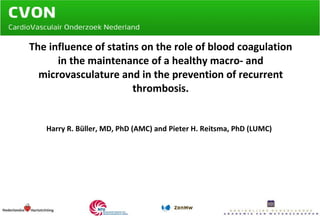Presentatie Prof. dr. B├╝ller en Prof. dr. Reitsma
- 1. The influence of statins on the role of blood coagulation in the maintenance of a healthy macro- and microvasculature and in the prevention of recurrent thrombosis. Harry R. B├╝ller, MD, PhD (AMC) and Pieter H. Reitsma, PhD (LUMC)
- 2. S. Middeldorp MD, PhD/J.C. Meijers PhD, AMC H. ten Cate MD, PhD/T. Hackeng PhD, MUMC F.R. Rosendaal MD, PhD/H.H. Versteeg PhD, LUMC K. Meijer MD, PhD/T. Lisman PhD, UMCG F. Leebeek MD, PhD/M. de Maat PhD, ErasmusMC Consortium The PIs and their collaborators represent all key researchers in the Netherlands in the field of hemostasis and thrombosis. Basic scientists in hemostasis/ thrombosis (Hackeng, Heemskerk, Spek, Van ŌĆś t Veer, Versteeg, De Groot, Meijers, Lisman, de Maat, van Heerde etc.), excellent epidemiologists (Rosendaal, Prins, Lijfering, and Cannegieter etc.) and seasoned clinical investigators (Ten Cate, Middeldorp, Leebeek, Huisman, Meijer etc) are brought together. The two research leaders are in their respective fields established opinion leaders and share relevant overlap. UUMC UMC St Radboud
- 3. Health Care problem Annually 2-3 per 1000 Europeans develop venous thromboembolism of whom >500.000 die of pulmonary embolism. Within 3-5 years, 20-25 % of the surviving patients have a venous recurrence, and they have a 2-3 times increased risk of MI/stroke There are two important unresolved issues in the management of patients with VTE What is the effect of anticoagulant treatment (VKAŌĆÖs, new oral anticoagulants) on vascular health? How can we improve the long-term prognosis of VTE (recurrence, arterial events, prediction)? The project aims to address all these aspects
- 4. Research questions ŌĆ£ The state of the haemostatic system is an important determinant of vascular health, which can be favourably influenced by statin treatmentŌĆØ To unravel how anticoagulant treatment influences vascular health To investigate the effects of statin on the the haemostatic system and vascular health To test in a prospective clinical trial whether statin treatment prevents recurrent thrombosis during and after anticoagulant treatment To enable prediction of venous recurrence and arterial disease
- 5. Research plan WP-1 Digging deeper: Investigating in-vivo/in-vitro the role of blood coagulation components and anti-thrombotic drugs in endothelial barrier function and atherosclerosis WP-2 Exploring new frontiers: Investigating in-vivo/in-vitro the effects of statins on blood platelets, blood coagulation/fibrinolysis and the thrombotic phenotype of the vascular wall WP-3 Probing the link: validating uncovered critical mechanisms in a clinical trial using statin treatment for prevention of recurrent venous thrombosis WP-4 Shaping the future: Development of predictive models of recurrent venous thrombosis and arterial thrombosis and analysis of its cost- effectiveness
- 6. Translation The research plan is divided in four workpackages, of which two (WP1-2) focus on fundamental aspects of the research questions, a third is devoted to the DuLac clinical trial (WP-3) and the last deals with translation of the findings to models of clinical decision making (WP-4). Discoveries in WP1 and -2 will be tested, validated, and subsequently further investigated with the help of WP-3 and -4 (bench-bedside-bench).
- 7. Focus areas Dutch Heart Foundation The project focus is on maintaining healthy blood vessels in an aging population There are marked gender differences in recurrence risks that will addressed Statins and their metabolic effects are a core activity of the project
- 8. Perspective The project will train 11 PhDs in the field of thrombosis and haemostasis which will stimulate this field in Dutch academic science and medicine. The project has allocated 500,000 euro to stimulate young talent and new ideas. The proposal forms the condensation point for existing and emerging European and transatlantic collaborations, including Bloodomics II (Cambridge University/Sanger Centre), European Network of Thrombosis Studies (Trondheim, Cambridge, Paris, Vienna, Troms├Č, Milan and Atlanta (CDC)), CONNECT (Paris, Munich, Cincinnati, and La Jolla), the Danish Cancer and Health cohort (Aarhus), and the CHARGE collaboration. Possibilities for ERC+ and Marie-Curie programs will be actively pursued
- 9. Focus on arterial and venous wall integrity combined Creates a platform for discovering novel pathways for recurrence prevention and treatment Scientific basis for translating the 50% reduction in VTE recurrence as well as in overall mortality - that has been observed in all retrospective analysis of statin treatment - into standard care Collaboration with the thrombosis services Incitement of an aging scientist Unique aspects of the project









